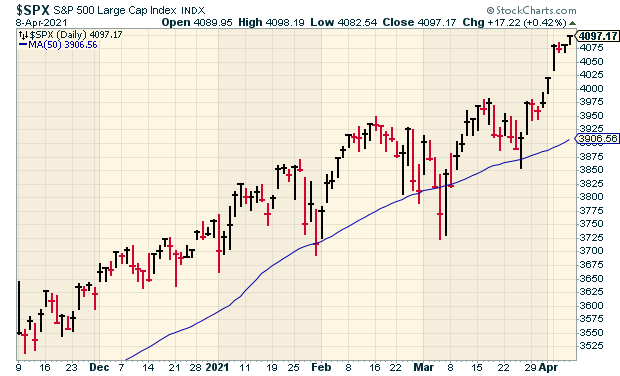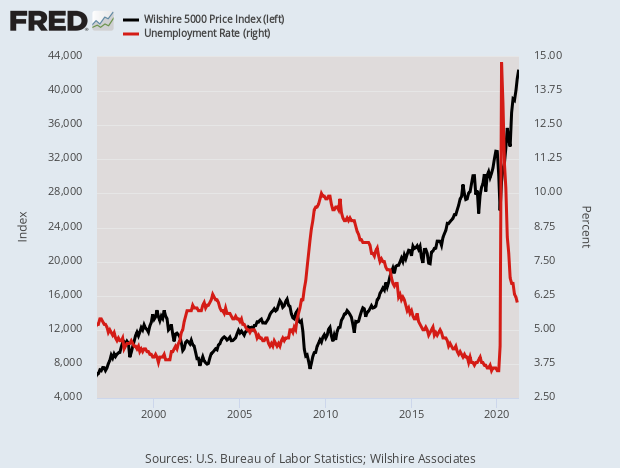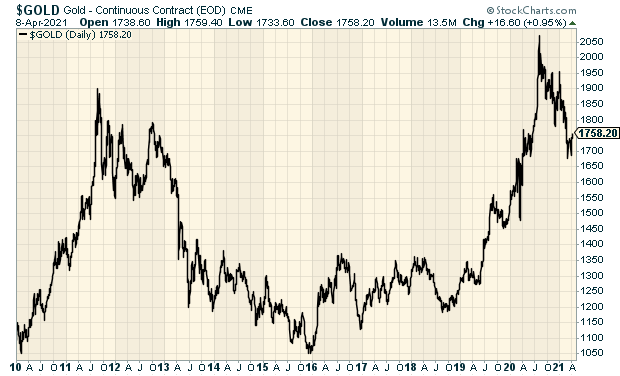CWS Market Review – April 9, 2021
“You should definitely get a one-year subscription to Eddy’s newsletter. It’s only $200!” – Napoleon
Before I start, I want to thank everyone for your support. Earlier this week, I decided to make CWS Market Review a paid newsletter, and your response has been overwhelming.
This week’s issue is open to everyone, but going forward, you’ll need to be a paid subscriber. You can sign up here.
Don’t worry, I’m keeping the price fairly modest. It’s $20 per month, or $200 for the whole year. I’ll probably raise that soon, but I want to give my loyal readers a discount.
I’ll continue to send out periodic updates to free subscribers, but fuller analysis will only be available on the paid service. I won’t give you the hard sell. This is the newsletter. It is what it is. I give you my honest take on the markets each week. I hope you continue with us.
Now, on to business.
We’re on the doorstep of the first-quarter earnings season. Things will really get going on Monday when several of the major banks are due to report. Our first Buy List earnings report looks to be Abbott Labs on Tuesday, April 20. After that, the reports will come in a blizzard. We’re going to get 22 earnings reports in about three weeks. Buckle up.
This is a key earnings season for several reasons. The most important is that Wall Street has made a big bet that corporate America will have good news to report. That’s why the indexes have been rising, and bond yields have crept higher.

Since late October, the S&P 500 has gained more than 25%. In retrospect, the rally didn’t seem that strong, perhaps because it came in little steps. In this week’s issue, I’ll discuss some recent economic news, including last week’s jobs report, and I’ll have some Buy List updates. The S&P 500 just made a new all-time high, and so have many of our Buy List stocks.
Since the financial news has been somewhat light lately, I thought I’d dig into my views on gold. I’m often asked about the yellow metal, so this is a good opportunity to share my perspective. Before we get to that, though, let’s look at last Friday’s big jobs report.
Best ISM Services Report on Record
Last Friday, the stock market was closed for Good Friday, but the Labor Department was open. The federales said that the U.S. economy created 916,000 net new jobs in March. That’s a huge number. Wall Street had been expecting a gain of only 675,000. The unemployment rate dropped to 6.0%.
In simple terms, the jobs situation has gone from a disaster to merely poor. So it’s an improvement, but we have to keep it in context. The details of the report were quite good. The private sector added 780,000 jobs, while the government added 136,000. The labor-force participation rate rose to 61.5%. That’s below the 63.3% we had in February 2020, but it’s a lot better than where it was a few months ago. Very roughly speaking, I’d say the U.S. economy is about eight or nine million jobs from full employment.
The jobs news suggest that the upcoming corporate-earnings news will be good. Again, in a relative sense. We hit a rough patch in February due to the weather, but it looks like Q1 was solid. It’s not just me saying the jobs outlook has improved; Federal Reserve Chairman Jay Powell also said as much this week. He said he wants to see a string of months of one million new jobs.
The IMF said it expects to see the U.S. economy grow by 6.4% this year. It also said that it expects to see world economic growth of 6%. That would be the strongest pace in four decades. Here’s a metaphor for the economy: we’re driving around in a broken truck, but it used to be stuck in the ditch. Check out this interesting 25-year chart of the stock market in black and the unemployment rate in red. The message is to buy when things are bad.

On Wednesday, the Fed released the minutes from its last meeting. As expected, the Fed didn’t make any changes to interest rates or its bond-buying policy. The minutes indicated that the Fed is willing to go all out to help the U.S. economy recover.
Specifically, the minutes said, “Participants noted that it would likely be some time until substantial further progress toward the Committee’s maximum-employment and price-stability goals would be realized and that, consistent with the Committee’s outcome-based guidance, asset purchases would continue at least at the current pace until then.” That’s Fedspeak for “dude, we’re not even close to done.”
Wall Street liked what it heard. On Thursday, the S&P 500 closed at 4,097.17, which is yet another all-time high.
Last week I told you how we had the best ISM Manufacturing Index report in 37 years. On Monday, we got even better news. The ISM Services Index report was the strongest one in its history. I believe that series goes back to 1997. For March, the ISM Manufacturing Index was 63.7.
The economy’s improvements have led to concerns about inflation. That’s sparked a debate about gold. Let me share my thoughts on the issue.
What to Make of Gold’s Slide?
With the Federal Reserve committed so strongly to helping the U.S. economy get back on its feet, some investors are concerned that we’ll see a resurgence of inflation. The recent movement in the gold market, however, has baffled some people. That’s because gold has dropped sharply over the last eight months.
If inflation is such a threat, shouldn’t gold be moving higher? This is a big topic on the minds of many investors in the gold corner of the market. I have to confess that I have slightly heterodox views on gold. (Prepare for a long-winded essay.)
There’s an old joke that there are exactly two people in the world who understand the price of gold. They both work for the Bank of England and they disagree.
Gold is an interesting but complex topic, so I’ll need some space to address it fully. For one, I don’t believe that gold responds to inflation. Rather, gold responds to real short-term interest rates. By this I mean interest rates adjusted for inflation. Inflation is part of the equation, but it’s not the only thing.
Basically, as long as real short-term rates are low, then you can expect gold to do well, but there’s a small caveat to this statement. Real short-term rates need to be low relative to the “natural interest rate.”
What do we mean by the natural interest rate? Now things get a little interesting. That’s the idea that there’s one magic interest rate that hangs over the entire world. The natural rate is sometimes called the Wicksellian rate in honor of the Swedish economist Knut Wicksell (1851-1926). You can’t see it, touch it or feel it. Nor does any media outlet report on what it closed at, but the natural rate covers the world, and everyone is impacted by it.
If the Fed brings rates below the natural rate, it’s helping the economy. If the Fed brings rates above the natural rate, it’s putting on the brakes. The problem is, no one knows exactly what the natural rate is.
Wherever the natural rate is, there seems to be widespread belief that in recent years the natural rate has declined. I’m in that camp as well. As a result, lower real rates haven’t had the impact on gold that they used to. Last summer, an ounce of gold cracked $2,000. Recently, it dipped below $1,700 per ounce.

I’m generally not much of a fan of investing in gold. That’s not an economic take or even a political view. Rather, it’s based on the view that gold is simply a rock. It doesn’t do anything. It just sits there. Gold has some industrial uses, but not many. In the long run, equity is a better and safer bet than assets.
For some reason, gold has bewitched man for millennia. There are some people, not all, who are quite simply unreasonably attracted to gold. They make Goldfinger look like an amateur. Maybe one day some cognitive scientist will find a connection between our brains and gold.
For example, gold never rusts. You can take the gold out of an Egyptian pyramid and stick it in a cavity in a tooth (though you might want to clean it first). It’s also non-toxic. And it’s also incredibly soft. One ounce can be stretched for 50 miles. It can be pounded down to a few millionths of an inch thickness. And gold is very heavy. Despite what you see in The Treasure of the Sierra Madre, gold dust can’t be blown away.
Gold has been found on every continent on earth. Gold has also had strong religious connections. It’s mentioned in the Bible more than 400 times. Marx writes of commodity fetishism, a term that’s meant to have a religious connotation.
A large part of the goldbug community is wedded to the idea of the gold standard and that civilization has been imperiled ever since the gold standard was left behind. Eh…maybe, but I’m more interested in finding things that make money. Some of the fervor may have migrated to the crypto world.
Also, gold tends to move in big price spikes. It’s either all or nothing. I understand why people might be attracted to gold, and I’m not unsympathetic. For me, however, I think the best way to build long-term wealth is to buy superior stocks and then do as little as possible. Now let’s look at news from our Buy List stocks.
Buy List Updates
Ansys (ANSS) is one of my favorite tech stocks. The company helps engineers see how their ideas look on a computer simulation. The stock got hit hard during the tech crunch in February, even though Ansys reported outstanding earnings for Q4. The stock has since reversed course and is up 23% in the last month. This week, I’m lifting my Buy Below price on Ansys to $375 per share. Look for another solid earnings report soon.
Several of our Buy List stocks have hit new highs lately or come very close. Middleby (MIDD) has gained 280% on a little over a year. On Thursday, shares of Ross Stores (ROST) rallied to a new 52-week high. I’m a big fan of Ross, but even I’ve been impressed with this stock’s resiliance lately. Along with Disney, this has become a favorite of the “reopening trade.” Ross Stores is a buy up to $130 per share.
Stryker (SYK) also hit a new high on Thursday. The company is due to report on April 27. Wall Street is looking for $1.99 per share. Stryker is a buy up to $260 per share.
That’s all for now. Looking at next week, we’ll get an update on the Federal budget on Monday. Then on Tuesday, the government releases its inflation stats for March. We still aren’t seeing much in the way of broad-based inflation, but that may soon change. Thursday will be crowded. We’ll get reports on retail sales and industrial production, plus the regular jobless-claims report. Then on Friday, we’ll get reports on housing starts and building permits. Be sure to keep checking the blog for daily updates. I’ll have more market analysis for you in the next issue of CWS Market Review!
– Eddy
P.S. Don’t forget to sign up for a premium subscription: $20 per month or $200 for the whole year!
Posted by Eddy Elfenbein on April 9th, 2021 at 7:08 am
The information in this blog post represents my own opinions and does not contain a recommendation for any particular security or investment. I or my affiliates may hold positions or other interests in securities mentioned in the Blog, please see my Disclaimer page for my full disclaimer.
- Tweets by @EddyElfenbein
-
-
Archives
- November 2024
- October 2024
- September 2024
- August 2024
- July 2024
- June 2024
- May 2024
- April 2024
- March 2024
- February 2024
- January 2024
- December 2023
- November 2023
- October 2023
- September 2023
- August 2023
- July 2023
- June 2023
- May 2023
- April 2023
- March 2023
- February 2023
- January 2023
- December 2022
- November 2022
- October 2022
- September 2022
- August 2022
- July 2022
- June 2022
- May 2022
- April 2022
- March 2022
- February 2022
- January 2022
- December 2021
- November 2021
- October 2021
- September 2021
- August 2021
- July 2021
- June 2021
- May 2021
- April 2021
- March 2021
- February 2021
- January 2021
- December 2020
- November 2020
- October 2020
- September 2020
- August 2020
- July 2020
- June 2020
- May 2020
- April 2020
- March 2020
- February 2020
- January 2020
- December 2019
- November 2019
- October 2019
- September 2019
- August 2019
- July 2019
- June 2019
- May 2019
- April 2019
- March 2019
- February 2019
- January 2019
- December 2018
- November 2018
- October 2018
- September 2018
- August 2018
- July 2018
- June 2018
- May 2018
- April 2018
- March 2018
- February 2018
- January 2018
- December 2017
- November 2017
- October 2017
- September 2017
- August 2017
- July 2017
- June 2017
- May 2017
- April 2017
- March 2017
- February 2017
- January 2017
- December 2016
- November 2016
- October 2016
- September 2016
- August 2016
- July 2016
- June 2016
- May 2016
- April 2016
- March 2016
- February 2016
- January 2016
- December 2015
- November 2015
- October 2015
- September 2015
- August 2015
- July 2015
- June 2015
- May 2015
- April 2015
- March 2015
- February 2015
- January 2015
- December 2014
- November 2014
- October 2014
- September 2014
- August 2014
- July 2014
- June 2014
- May 2014
- April 2014
- March 2014
- February 2014
- January 2014
- December 2013
- November 2013
- October 2013
- September 2013
- August 2013
- July 2013
- June 2013
- May 2013
- April 2013
- March 2013
- February 2013
- January 2013
- December 2012
- November 2012
- October 2012
- September 2012
- August 2012
- July 2012
- June 2012
- May 2012
- April 2012
- March 2012
- February 2012
- January 2012
- December 2011
- November 2011
- October 2011
- September 2011
- August 2011
- July 2011
- June 2011
- May 2011
- April 2011
- March 2011
- February 2011
- January 2011
- December 2010
- November 2010
- October 2010
- September 2010
- August 2010
- July 2010
- June 2010
- May 2010
- April 2010
- March 2010
- February 2010
- January 2010
- December 2009
- November 2009
- October 2009
- September 2009
- August 2009
- July 2009
- June 2009
- May 2009
- April 2009
- March 2009
- February 2009
- January 2009
- December 2008
- November 2008
- October 2008
- September 2008
- August 2008
- July 2008
- June 2008
- May 2008
- April 2008
- March 2008
- February 2008
- January 2008
- December 2007
- November 2007
- October 2007
- September 2007
- August 2007
- July 2007
- June 2007
- May 2007
- April 2007
- March 2007
- February 2007
- January 2007
- December 2006
- November 2006
- October 2006
- September 2006
- August 2006
- July 2006
- June 2006
- May 2006
- April 2006
- March 2006
- February 2006
- January 2006
- December 2005
- November 2005
- October 2005
- September 2005
- August 2005
- July 2005
 Eddy Elfenbein is a Washington, DC-based speaker, portfolio manager and editor of the blog Crossing Wall Street. His
Eddy Elfenbein is a Washington, DC-based speaker, portfolio manager and editor of the blog Crossing Wall Street. His